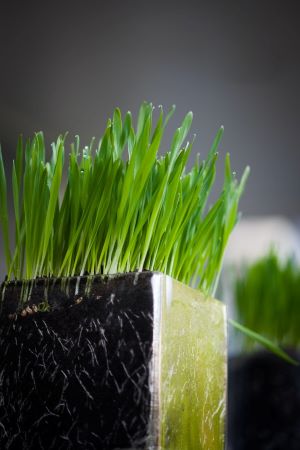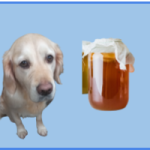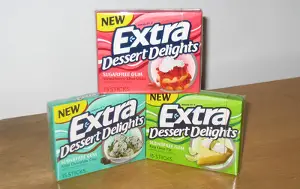
You have a new health craze, a superfood which is getting you really excited.
Perhaps you are eating it because like 95% of Americans you don’t have enough fiber in your diet.
Or maybe it is because you like the sound of how the chlorophyll might improve the oxygen levels in your blood.
More energy, right?
For whatever reason, this stuff is making you feel good- buzzing would be a better word.
And as you make your smoothie and add your wheatgrass powder, your canine shadow is taking it all in.
And this gets you thinking…
Feeding your dog a smoothie is a bit of a stretch but could they benefit from a bit of added wheatgrass in their bowl?
Stick with me and find out.
What is wheatgrass?
As the name suggests, wheatgrass is the grass of a wheat plant.
Although it is by definition a wheat plant, it is gluten free because it’s harvested young before it develops gluten.
Wheatgrass is regarded as a superfood because it contains many potent nutrients, such as vitamins A, C, E, K, mineral, iron, and magnesium, so much so that it’s sometimes called a “complete food”.
What nutritional benefits does it provide to dogs?
First of all, it contains a high amount of fiber and magnesium, boosting the digestive system and keeping their bowels healthy.
This could prevent your dog from bowel problems such as bloating, vomiting, diarrhea, and constipation.
Having a healthy digestive system can also mean maintaining a healthy weight.
While it is true that we want our canines to be happy, giving them any kind of food they want is not the answer.
You need to provide your pet with a balanced diet so that they can stay healthy and active. Adding wheatgrass to your dog’s meal is a perfect solution to that.
Aside from bowel health, wheatgrass promotes gum and oral health.
Its high chlorophyll levels help prevent gum bacteria diseases and bad breath.
Wheatgrass also helps in improving red blood cell levels.
Just like humans, dogs need iron for blood synthesis, and wheatgrass contains a lot of iron.
Having a sufficient amount of blood cells gives your dog more energy to play around.
Another benefit of wheatgrass is its anti-inflammatory properties.
It helps protect your dog from infections.
And as if all of the above weren’t enough, wheatgrass also could make a dog’s coat look shinier.
What is the difference between wheatgrass and regular grass?
This shouldn’t come as a surprise, but the grass that covers your lawn or your local park is a bit different from wheat grass.
You must have watched your dog eat grass at some point in the past?
And when dogs eat grass, two things can happen.
Either they vomit it back up or it comes out of their bum when they poop.
Dogs can’t digest regular grass- their stomachs aren’t designed for.
And neither can we digest it either!
You have heard that cows, who live to eat grass, have two stomachs right?
And they need every inch of those two stomachs to digest grass to break it down and extract all that goodness from it.
Dogs and humans can’t break grass down as it has far too much cellulose in it.
And because it can’t be digested, a dog doesn’t benefit from any nutrients that it might contain.
Dogs can more easily digest wheatgrass.
And then there are the obvious problems that regular grass is much more likely to be contaminated.
Fertilisers, pesticides or just full of parasites and bacteria deposited by other wildlife.
Wheatgrass also contains a lot more nutrients than regular grass.
While regular grass is also rich in mineral and chlorophyll, it doesn’t have the high content of iron, magnesium, and antioxidants that wheatgrass has.
Powder vs Juice powder vs Growing your own wheatgrass
Wheatgrass is available in many forms, from the readily available powder and juice to self-planted wheatgrass.
You can feed your dog any of these wheatgrasses, but which one is the best for them?
Between wheatgrass powder and wheatgrass juice, the difference actually lies in their nutrients.
Even though they’re made from the same main ingredient, the way they’re formulated affects the other components of the food.
Wheatgrass powder has up to 4 times more fiber than wheatgrass juice.
On the other hand, wheatgrass juice contains more vitamins, calcium, chlorophyll, and iron.
Compared to self-grown wheatgrass, wheatgrass powder and wheatgrass juice are more practical.
You can serve them by just blending it as a juice or sprinkling a small amount on their meal.
If you grow your own wheatgrass, you will need to spare more time to take care of the plant.
However, growing your own wheatgrass has the obvious benefit of being able to know that it is 100% safe for your dog.
Another benefit is that you can serve it in several forms: juice it or giving it to your dog in its natural grass state.
If you are feeding your dog wheatgrass as an alternative to lawn grass, it is better for you to give it in its grass form to provide your dog the satisfaction they seek when munching on grass.
All types of wheatgrasses have their upsides and downsides.
When choosing wheatgrass for your pet, you should cater to your dog’s personal needs.
If you’re looking to boost their digestive system, the powder form might be a better idea because it’s rich in fiber.
If you want to target your dog’s bad breath, you should try the wheatgrass juice because it contains more chlorophyll.
There’s also the matter of pricing.
Wheatgrass juice and wheatgrass powder forms are similarly priced- depending on the quality (such as whether it is organic or not.)
If you are going to buy seeds you get far more for your money- because of all the work that you need to in order to create the finished product!
How much wheatgrass should I feed my dog?
Since wheatgrass packs so many antioxidants, eating too much of it may induce diarrhea, so be careful not to give them too much of it.
For wheatgrass powder and juice powder, follow the serving instructions on the product.
It’s usually around 1 tsp for small dogs below 5 kg and 1 tbsp for large dogs more than 5 kg. As for fresh wheatgrass, it’s better to consult your vet.
Can wheatgrass help sick dogs?
While wheatgrass has been said to aid in treating cancer in humans, there is not much scientific research to back it up.
Therefore, giving your dog wheatgrass won’t cure them from cancer.
However, the high antioxidant content in it helps in fighting free radicals which is highly associated with cancer development.
This is good for dogs because they eat a lot of fats which can be oxidized to free radicals.
It should still be kept in mind that wheatgrass will not directly help curing canine cancer.
Overall, it is the high content of various important nutrients that makes wheatgrass a very good meal to help sick dogs recover.
The high levels of antioxidant, vitamins, and magnesium that wheatgrass provides will give a healthier and more active body.
Wheatgrass alternatives
While wheatgrass is a great supplement for your dog, you might not be able to access it for a variety of reasons.
There are several foods you can give your dog as an alternative to wheatgrass.
Coconut oil has many similar properties as wheatgrass.
It prevents bad breath, improves digestion, and makes a dog’s coat shinier.
Fish oil is also a popular supplement for dogs because it supports heart health, reduces itchy skin, and helps relieve allergies.
Similar to wheatgrass, fish oil also contains a high level of antioxidants that help in fighting free radicals.
Another alternative to wheatgrass is aloe vera juice, as it also promotes gut health and contains vitamins A, C, E, and magnesium.
How to grow your own wheatgrass?
The best thing about wheatgrass is its practicality.
It’s very easy to plant and it grows very fast because we’re only looking to use the newly sprouted grass.
There are also various ways you can plant them, using soil or soil-less (with hydroponic technique using rockwool or cocopeat).
How to plant wheatgrass:
- Soak the wheatgrass seeds in water and leave it overnight. This softens the outer skin, allowing the seed to absorb water more quickly when they’re planted so that they sprout faster.
- Prepare the planting medium of your choice in the growing container (can be a pot or seedling tray).
- Separate the seeds from water by straining them. Spread the seeds in the planting medium and don’t forget to cover the wheatgrass seeds with another thin later of the planting medium. If you’re using rockwool, you can cover the seeds using a little cocopeat.
- Water the medium two times a day, every morning and afternoon. Never leave a puddle of water on it because wheatgrass seeds are extremely prone to rotting and mold.
- From the first to the third day, cover the seeding medium with newspaper and keep away from direct sunlight.
- Remove the newspaper on the fourth day, you should already be able to spot sprouting. Move them to a place where they can get sunlight but not directly.
- Harvest them when they’re about 5 inches. Cut the top two-thirds of the grass and it’s ready to consume.
Closing Thoughts
Wheatgrass is a complete nutritious food you can give as a supplement to your dog.
It has a lot of nutritional benefits, from promoting bowel health to fighting infections and cancer-inducing radicals.
Available in many forms, you can try one that suits your and your dog’s needs.
You can even try growing it yourself as it is very easy to maintain and sprouts in a small amount of time.
Give your dog the best nutrients by giving them a wheatgrass supplement.






